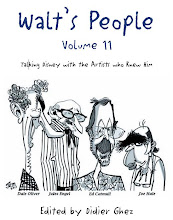Didier Ghez: How did you get the idea
to write this book?
Amid Amidi: The seed was planted when I
interviewed Ward in 2000 about his colleague Tom Oreb. After the interview, we
walked out to Ward's storage shed to find a painting he'd made of Oreb. His
storage was dusty, but meticulously organized with dozens of neatly labeled
boxes. I was excited when Ward said he wanted to show me some work besides that
painting. He pulled out a large flat box that contained figure drawings from
the 1940s. The drawings were beautiful and had a real sense of caricature to
them. When I looked at those drawings in front of me and all the surrounding
boxes, it struck me that there's a lot more to Ward than I knew. There's that
famous quote where Walt Disney said, “Ward’s
the one man who works for me I call a genius.” I wanted to understand
what Walt truly meant when he singled out Ward from the rest of the studio.
That required taking a step back and looking at Ward not simply as an animator,
but as an artist first and foremost.
DG: Did you get collaboration
from the family and did you get access to the famous Kimball diaries?
AA: This book would not have
been possible without the Kimball family's cooperation. When Ward died in 2002,
I kept in touch with the family. Whenever I saw Ward's son, John, around town,
I'd casually mention that I wanted to write a book about Ward. After
"Cartoon Modern" was published in 2006, I was looking for another
project and decided that the time was right to pursue this bio. That's when I
approached the Kimball family with the idea for the book. They made his entire
personal archive available to me—a sizable collection of art, documents and
photographs. Ward's wife, Betty, was a huge help and she filled in many of the
details. The legendary Kimball diaries were off-limits initially, but a couple
years into the project, I became the first historian who was allowed access to
those. I'm grateful for that because it enhanced my understanding of Ward's
work tremendously and allowed me to tell the complete story of his life.
DG: Could you give us some
information about the content of the diaries?
AA: Ward’s Disney-era journals comprise three bound volumes totaling
nearly 1,400 pages. He kept them between September 1939, and the end of 1948.
(He skipped the year 1945, and there are extended gaps in some of the other
years.) The diaries are interesting both for what they contain and for what
they don't. There are many things Ward hints at, but doesn't follow up on.
Clearly, they were personal notes intended to help him remember events in his
life, not some grand statement on his philosophies or art. Having said that,
they contained invaluable nuggets of information that shed light on life at the
Disney studio in the 1940s. His account of the Disney studio strike of 1941 is
fascinating and will hopefully be made available someday for the sake of
animation history. Ward's entries about the strike give a real sense of the
stakes, both for the artists on the inside and outside.
DG: How long is the book and what are the highlights?
AA: The book is comprised of
eleven chapters spread over 240 pages. There's a lot of ground to cover, and I
had to convince my editor to add more pages on two separate occasions. For me
personally, the biggest highlight is simply that this is not your typical
animation history book. Anybody who works in a big animation studio will
empathize with Ward's story and appreciate how ferociously he fought to
preserve his personal voice while working at Disney. He was loyal to a fault to
Walt, yet he was anything but a company man, and that tension drives much of
the work he produced as an artist.
DG: What are the key discoveries you made while
conducting your research?
AA: I never knew how close the
relationship was between T. Hee and Ward. They were great friends, and Hee was
the one who pushed him toward a more design-oriented approach to drawing long
before Ward directed "Melody" and "Toot Whistle Plunk and
Boom." Ward's relationship with Fred Moore was also intriguing, and
evolved in directions I never anticipated when I first started working on the
book.
I was perhaps most
surprised by the creative struggle involved in the work that he created. When
we look at the classic characters and sequences that Ward animated, we assume
he arrived at work every day, sat down at his desk, and pumped out beautiful
animation. In reality, there was immense external and internal pressure
weighing down on him during almost every production. For example, he struggled
to get a handle on Jiminy Cricket in "Pinocchio" until there was
barely any production time left, had a nervous breakdown while working on the
crows in "Dumbo," and had to redo a significant amount of the
animation in the Mad Tea Party sequence of “Alice in Wonderland” due to
creative conflicts with Walt. There was so much upheaval and creative conflict
during the production of "Pecos Bill" that it's amazing it turned out
as well as it did.
The book will hopefully
dispel the one-dimensional picture of Ward as a zany prankster who provided
comic relief for others at the studio. He was an amusing figure to be sure, but
he was also one of the smartest and savviest people who worked at the company.
Ward pushed himself harder than anybody, and pursued an idea until he had
realized its creative potential. A great example of this is his music career. The
Firehouse Five Plus Two took off in the late-1940s, but it was hardly an
overnight success. Ward had worked the better part of a decade prior to that
learning how to lead a band and developing his voice as a musician.
And speaking of the Firehouse
Five Plus Two, I was surprised by how popular the band was during the 1950s.
From our modern-day perspective, they often appear like some kind of fringe
musical novelty group. But when they exploded onto the scene in 1950, they were
a national sensation and received massive media exposure. They were a household
name for the rest of the decade and well into the Sixties. For much of the
1950s and '60s, Ward was better known by the general public for his music than
his work at Disney.
DG: What are the most interesting visual documents we
will discover in the book?
AA: There's literally hundreds
of images in the book, most never-before-published, and each I hope will reveal
something new about Ward or his work. There's tons of personal drawings, paintings,
gag drawings, and photos, along with rare pieces like his retirement notice to
the studio in 1973, a
hilarious two-page letter that Walt Kelly wrote to him which illustrates their
warm relationship better than anything I could write, examples of Ward's animation
thumbnails, and rare images from the WWII-era USO camp shows that contained the
seeds of the Firehouse Five Plus Two.


























6 comments:
Can't wait to read this. Would be nice to start seeing individual biographies of artists her helped Walt realize his dream and who themselves became very accomplished in the process.
This is happening. Next one up is the biography of Art Babbitt by Jake Friedman.
I will definitely be buying this book!
Hopefully you found some of Ward's Train Collector's Association Quarterly illustrations and photos. While not always his most creative work, he did some interesting things for such a "straight" subject.
Brian O.
Just put this on my wish list. I'll pre-order it soon. In retrospect I always find it funny that I knew about Ward & Betty Kimball (though I never met them) via "Trains Magazine." I was a huge steam locomotive fan as a kid and somewhere I have a article that Trains did about them sometime in the late 1970's.
Warren Crandall
Grass Valley, CA.
Brian O. and everyone interested: Regarding the Emma Nevada locomotive, Ward did a drawing of that, that hangs inside the Emma Nevada House in Nevada City, California. The house was built by her father and is now a bed and breakfast.
Warren Crandall
Grass Valley, CA
Post a Comment